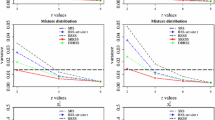Abstract
Ranked set sampling was introduced by McIntyre (1952,Australian Journal of Agricultural Research,3, 385–390) as a cost-effective method of selecting data if observations are much more cheaply ranked than measured. He proposed its use for estimating the population mean when the distribution of the data was unknown. In this paper, we examine the advantage, if any, that this method of sampling has if the distribution is known, for a specific family of distributions. Specifically, we consider estimation of μ and σ for the family of random variables with cdf's of the formF(x−μ/σ). We find that the ranked set sample does provide more information about both μ and σ than a random sample of the same number of observations. We examine both maximum likelihood and best linear unbiased estimation of μ and σ, as well as methods for modifying the ranked set sampling procedure to provide even better estimation.
Similar content being viewed by others
References
Abramowitz, M. A. and Stegun, I. A. (1968).Handbook of Mathematical Functions, National Bureau of Standards, Washington, D.C.
Dell, T. T. and Clutter, J. L. (1972). Ranked set sampling theory with order statistics background,Biometrics,28, 545–555.
Gore, S. D., Patil, G. P. and Sinha, A. K. (1994). Environmental chemistry, statistical modeling, and observational economy,Environmental Statistics, Assessment, and Forecasting (eds. C. R. Cothern and N. P. Ross), 57–97, Lewis Publishing/CRC Press, Boca Raton.
Johnson, G. D., Patil, G. P. and Sinha, A. K. (1993). Ranked set sampling for vegetation research,Abstracta Botanica,17, 87–102.
Lloyd, E. H. (1952). Least squares estimation of location and scale parameters using order statistics,Biometrika,39, 88–95.
McIntyre, G. A. (1952). A method for unbiased selective sampling using ranked sets,Australian Journal of Agricultural Research,3, 385–390.
Mosteller, F. (1946). On some useful inefficient statistics,Ann. Math. Statist.,17, 377–407.
Muttlak, H. A. and McDonald, L. L. (1990). Ranked set sampling with respect to concomitant variables and with size biased probability of selection,Comm. Statist. Theory Methods,19, 205–219.
Ogawa, J. (1951). Contributions to the theory of systematic statistics,Osaka Mathematical Journal,3, 175–213.
Patil, G. P. and Taillie, C. (1993). Environmental sampling, observational economy, and statistical inference with emphasis on ranked set sampling, encounter sampling, and composite sampling,Bulletin ISI Proceedings of 49th Session, 295–312, Firenze.
Patil, G. P., Sinha, A. K. and Taillie, C. (1993a). Ranked set sampling from a finite population in the presence of a trend on a site,Journal of Applied Statistical Science,1, 51–65.
Patil, G. P., Sinha, A. K. and Taillie, C. (1993b). Observational economy of ranked set sampling: comparison with the regression estimator,Environmetrics,4, 399–412.
Patil, G. P., Sinha, A. K. and Taillie, C. (1994). Ranked set sampling,Handbook of Statistics Volume 12: Environmental Statistics (eds. G. P. Patil and C. R. Rao), 167–200, North Holland/Elsevier Science Publishers, New York and Amsterdam.
Ridout, M. S. and Cobby, J. M. (1987). Ranked set sampling with non-random selection of sets and errors in ranking,Applied Statistics,36, 145–152.
Sinha, Bimal K., Sinha, Bikas K. and Purkayastha, S. (1994). On some aspects of ranked set sampling for estimation of normal and exponential parameters,Statist. Decisions (in press).
Stokes, S. L. (1977). Ranked set sampling with concomitant variables,Comm. Statist. Theory Methods,6, 1207–1211.
Stokes, S. L. (1980). Estimation of variance using judgment ordered ranked set samples,Biometrics,36, 35–42.
Stokes, S. L. and Sager, T. W. (1988). Characterization of a ranked set sample with application to estimating distribution functions,J. Amer. Statist. Assoc.,83, 374–381.
Takahasi, K. and Wakimoto, K. (1968). On unbiased estimates of the population mean based on the sample stratified by means of ordering,Ann. Inst. Statist. Math.,20, 1–31.
Yanagawa, T. and Shirahata, S. (1976). Ranked set sampling theory with selective probability matrix,Austral. J. Statist.,18, 45–52.
Author information
Authors and Affiliations
Additional information
This paper has been prepared with partial support from the United States Environmental Protection Agency under Cooperative Agreement Number CR821801-01-0. The contents have not been subjected to Agency review and therefore do not necessarily reflect the views or policies of the Agency and no official endorsement should be inferred.
About this article
Cite this article
Stokes, L. Parametric ranked set sampling. Ann Inst Stat Math 47, 465–482 (1995). https://doi.org/10.1007/BF00773396
Received:
Revised:
Issue Date:
DOI: https://doi.org/10.1007/BF00773396




